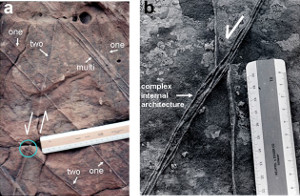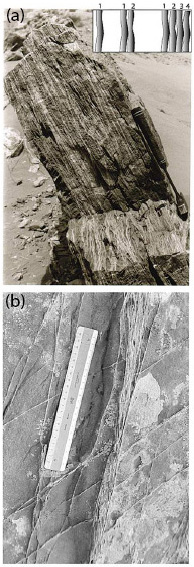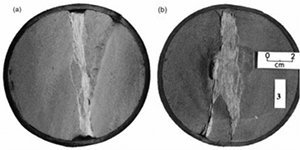| |||||||
|
|
|||||||
|
|
|||||||
| Mechanisms and Mechanics of Shear Band Zone | |||||||
|
Shear band zones occur in various thicknesses which are controlled primarily by the number of bands within the zones as marked in Figure 1(a) and Figure 1(b). Figure 2 and the inset shows that individual bands are sequentially added. The bands generally have straight traces in sections which include the slip vector, while they are curvilinear and inosculating in sections at high angles to the slip vectors. Shear band zones are known as Riedel Shears with the opposite sense of shearing with reference to the experimental work of Riedel (1929). See 'Multiple Sets of Shear Band Zones.' It is also possible that the splays may be dominated by volumetric strain localization as shown under 'Splay Volumetric Bands.' Shear band zones remarkably similar to those observed in the field have also been produced in the laboratory (see Figure 3) by Muir et al. (2002). These zones formed by sequential addition of shear bands thereby supporting the mechanism proposed earlier based on the field data. | |||||||
| Reference: |
|||||||
| Aydin, A., 1977 Aydin, A., 2006 Mair, K., Main, I., Elphick, S., 2000 Riedel, W., 1929 |
|||||||
|
Readme | About Us | Acknowledgement | How to Cite | Terms of Use | Ⓒ Rock Fracture Knowledgebase |
|||||||


